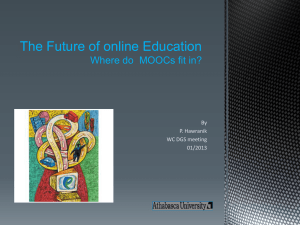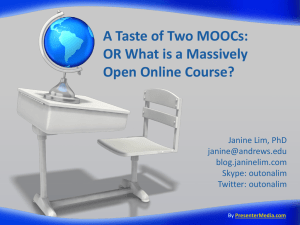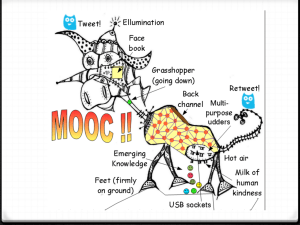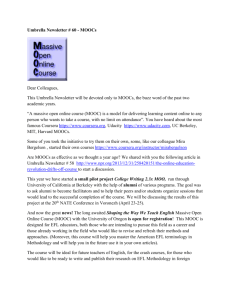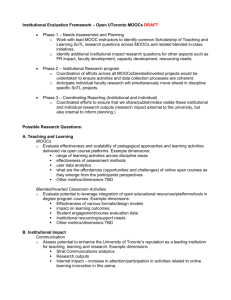20120926 Korea University MOOCs (Text)
advertisement
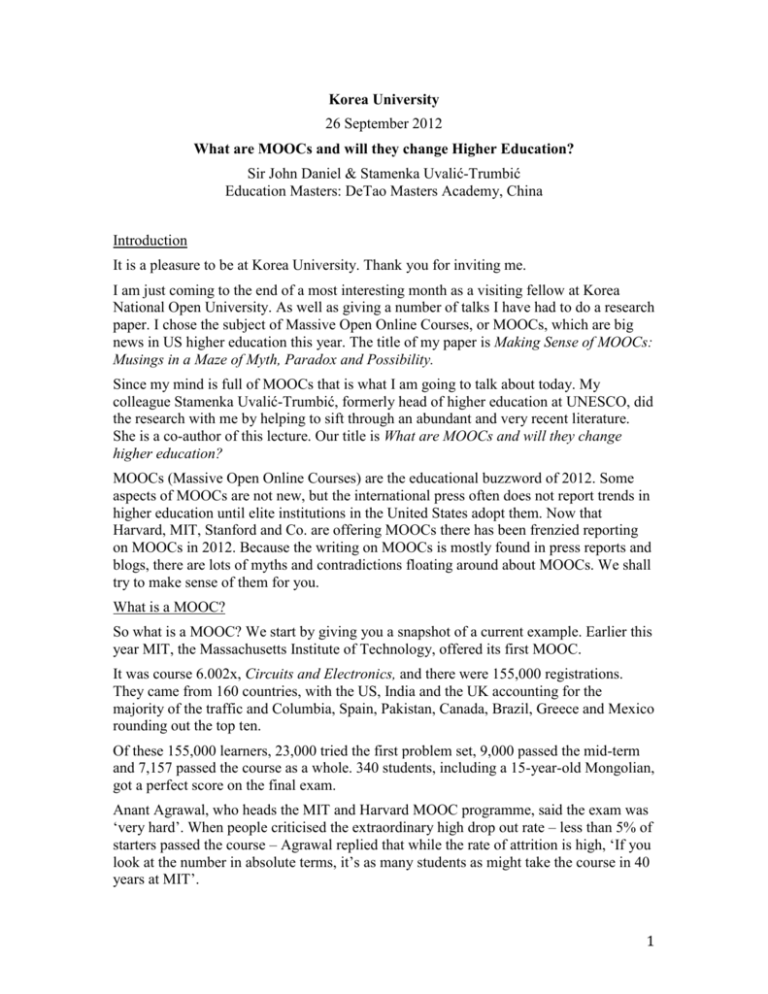
Korea University 26 September 2012 What are MOOCs and will they change Higher Education? Sir John Daniel & Stamenka Uvalić-Trumbić Education Masters: DeTao Masters Academy, China Introduction It is a pleasure to be at Korea University. Thank you for inviting me. I am just coming to the end of a most interesting month as a visiting fellow at Korea National Open University. As well as giving a number of talks I have had to do a research paper. I chose the subject of Massive Open Online Courses, or MOOCs, which are big news in US higher education this year. The title of my paper is Making Sense of MOOCs: Musings in a Maze of Myth, Paradox and Possibility. Since my mind is full of MOOCs that is what I am going to talk about today. My colleague Stamenka Uvalić-Trumbić, formerly head of higher education at UNESCO, did the research with me by helping to sift through an abundant and very recent literature. She is a co-author of this lecture. Our title is What are MOOCs and will they change higher education? MOOCs (Massive Open Online Courses) are the educational buzzword of 2012. Some aspects of MOOCs are not new, but the international press often does not report trends in higher education until elite institutions in the United States adopt them. Now that Harvard, MIT, Stanford and Co. are offering MOOCs there has been frenzied reporting on MOOCs in 2012. Because the writing on MOOCs is mostly found in press reports and blogs, there are lots of myths and contradictions floating around about MOOCs. We shall try to make sense of them for you. What is a MOOC? So what is a MOOC? We start by giving you a snapshot of a current example. Earlier this year MIT, the Massachusetts Institute of Technology, offered its first MOOC. It was course 6.002x, Circuits and Electronics, and there were 155,000 registrations. They came from 160 countries, with the US, India and the UK accounting for the majority of the traffic and Columbia, Spain, Pakistan, Canada, Brazil, Greece and Mexico rounding out the top ten. Of these 155,000 learners, 23,000 tried the first problem set, 9,000 passed the mid-term and 7,157 passed the course as a whole. 340 students, including a 15-year-old Mongolian, got a perfect score on the final exam. Anant Agrawal, who heads the MIT and Harvard MOOC programme, said the exam was ‘very hard’. When people criticised the extraordinary high drop out rate – less than 5% of starters passed the course – Agrawal replied that while the rate of attrition is high, ‘If you look at the number in absolute terms, it’s as many students as might take the course in 40 years at MIT’. 1 That’s a snapshot of the present, but let us start at the beginning. The term MOOC originated in Canada. Cormier and Alexander invented the acronym to describe an open online course at the University of Manitoba designed by George Siemens and Stephen Downes. The course, Connectivism and Connective Knowledge, was presented to 25 fee-paying students on campus and 2,300 other students from the general public who took the online class free of charge. The course title gives you its flavour. It was inspired by Ivan Illich’s philosophy, in his book Deschooling Society, that an educational system should ‘provide all who want to learn with access to available resources at any time in their lives; empower all who want to share what they know to find those who want to learn it from them; and, finally furnish all who want to present an issue to the public with the opportunity to make their challenge known’ In this spirit ‘all the course content was available through RSS feeds, and learners could participate with their choice of tools: threaded discussions in Moodle, blog posts, Second Life and synchronous online meetings’. These early MOOCs, which we shall call cMOOCs (for ‘connecting’ MOOCs) are very different from the MOOCs attracting media attention today, which we call xMOOCs after edX, the MIT, Harvard and UC Berkeley consortium that is offering them. xMOOCs have nothing to do with Illich’s liberal educational philosophy. One writer says xMOOCs are ‘at the intersection of Wall Street and Silicon Valley’ and they have little relation to the pioneering cMOOC courses. We find the philosophy of the cMOOC courses of connecting people together very attractive, but in this talk we shall focus on the xMOOCs because they are what are making the news. Some of the creators of cMOOCs believe that with time the xMOOCs movement will return to some of their methods and philosophy and indeed, the Massachusetts Institute of Technology (MIT) is beginning, timidly, to connect its students in this way. Don’t forget that xMOOCs are very new. Early in 2012 Stanford University offered a free, chunked Artificial Intelligence course online and 58,000 people signed up. MIT announced MITx at the end of 2011 for a launch in spring 2012. Since then there have been many similar ventures from other well known US universities. There seems to be a herd instinct at work as universities observe their peers joining the xMOOCs bandwagon and jump on for fear of being left behind. Today Coursera, a new for-profit company that helps universities do xMOOCs, already claims nearly 1.4m registrations and will offer 200 courses in late 2012 with 33 partner institutions, of which the large majority are in the US. But even within the xMOOC movement we see differences in purpose and approach. One reporter has made a useful comparison of the MIT xMOOC programme and the courses that Coursera has offered with 13 universities in the US and abroad. He interviewed some of the players and enrolled in a Coursera course himself and concluded that these two approaches to massive online learning are significantly different. 2 MIT’s effort is rooted in a strategy, going back 15 years, of using online learning to improve and change its teaching on campus. The launch of MIT Open Courseware in 2001 was part of this policy and it is significant that L. Rafael Reif, who as provost oversaw the creation of MITx, has recently been appointed president of MIT. This reporter suggests that MIT considers online learning to be a disruptive technology and is using MITx as a laboratory to master it in order to learn how to educate its oncampus students better. Stanford University is using a similarly careful approach. John Mitchell, the vice-provost responsible for online learning at Stanford, says: ‘what can we learn about teaching and learning through experimenting with different forms of technology? So I think we're going to treat this as an intellectual question and an academic investigation in some sense’. He added: ‘we really want to see what works… it’s not clear that the current mode of producing courses is where we’re going to end up in five years’. Armstrong observes that some Coursera institutions have a quite different attitude from MIT. For them, xMOOCs are a sideline, not core business. Provosts at two of the institutions said that they were not providing any pedagogical help for faculty in the preparation of the courses and even ‘looked confused at the question’. His experience of taking one of the courses reinforced his view that they were a low priority for these universities. He found the pedagogy weak. Indeed, he concluded, ‘it seems pretty obvious that no one who had any working knowledge of research in pedagogy was deeply involved in the creation of the course’. Non-starts, dropouts, completers and cheats: early results Like the first MIT course we started with, the Coursera courses have also had terrific dropout rates. All xMOOC providers have been trying to defend this terrible performance to sceptical media reporters. However, in line with its strategy of trying to improve teaching generally, MIT is making some changes. For example, in response to student demand left the 6.002x course website up at the end of the term. A group of 6.002x students have now created their own version of the follow-up course, 6.003, Signals and Systems, using material from MIT’s OpenCourseware site. Students also wrote their own programmes, such as an online text viewer for mobile devices) to augment the MITx platform and MIT made these available through the course wiki. MIT is also making easier for students to ‘customise the course content’ by extending homework and exam deadlines. An interesting footnote was research on the course which showed that students much preferred ‘shaky hand drawings that took shape as the professor lectured’ to polished PowerPoint slides. The media and bloggers have been tougher on Coursera than on MIT. Another reporter found that ‘some classes were so rife with plagiarism that professors have had to plead with their students to stop plagiarizing’. Part of the problem, one student says, is that Coursera lets students mark each others work because there are so many of them. MOOCs in perspective 3 Let us try to put xMOOCs in perspective. Innovators like to believe that theirs is the real revolution. But let’s remember people have been expecting technology to transform education for a long time. In 1841 the inventor of the blackboard considered to be among the greatest benefactors to mankind’. A century later, in 1940, the motion picture was called the most revolutionary instrument introduced into education since the printing press. Television was the educational revolution in 1957. In 1962 it was programmed learning and in 1967 computers. Each was labelled the most important development since Gutenberg’s printing press. Since 2000 there have been many claims that Internet and communications technologies (ICT) could revolutionise all aspects of education because they absorb all those previous innovations. We said earlier, for instance, that xMOOC learners preferred teachers to scrawl formulae on a whiteboard rather than showing slides. We believe that modern ICT, what we sometimes call the ‘knowledge media’, are qualitatively different from previous educational technologies. That is because they lend themselves naturally to the manipulation of symbols (words, numbers, formulae, images) that are the heart of education, as well as providing, through the Internet, a wonderful vehicle for the distribution and sharing of educational material at low cost. But while there is no doubt about the potential of ICT to improve, extend cut the cost of education, the results so far have often been disappointing. People have short memories. It is surprising that in the current frenzy of reporting on xMOOCs, no reference is made to the unhappy experience of some elite US schools with online learning as recently as the middle of the last decade. Those failed ventures have been well documented in Taylor Walsh’s recent book Unlocking the Gates. She records how universities such as Columbia, Chicago, the London School of Economics, Oxford, Yale and Stanford thought they could make useful additional money by offering non-credit courses online. In the event they and their partners lost plenty of money before their ventures, called Fathom and AllLearn were shut down. The Allearn website is still there, wistfully explaining that in 2006: ‘AllLearn offers over fifty online courses from Oxford, Stanford, and Yale Universities. Courses are available to anyone — anywhere and at any time. Expert online instructors help you to explore fully the readings and lectures and share in lively discussions with your classmates’. By that time some other universities were already taking a different route. From the late 1990s MIT had experimented with putting materials associated with its credit courses on the web for free. This was announced as the MIT OpenCourseware project in 2002. Later the same year, at a UNESCO Forum on the Impact of Open Courseware for Higher Education in Developing Countries, the term Open Educational Resources was coined. Note that the subtitle to Walsh’s book, How and why leading universities are opening up access to their courses, is misleading. The Fathom and Allearn ventures only offered non-credit courses, which was a main reason why the ventures failed, and MIT was simply letting people look at materials supporting its 4 courses. Millions, including some of you we expect, did and still do look at MIT courseware. But MIT explicitly did not offer interaction with its faculty and certainly not the possibility of obtaining an MIT credential. People criticised MIT for this patronising approach and this criticism, coupled with MIT’s long-term strategic planning for online learning that we mentioned, led to the current xMOOC developments. Before leaving Walsh’s book we highlight a quote in its final pages from former Princeton University President Harold Shapiro. His words are ironic now that Princeton is offering xMOOCs with the Coursera company. Shapiro doubted the traditional university’s capacity to expand seamlessly into other areas, saying that in deciding where to focus resources, a university must consider what will support its public mission. ‘But you also have to ask yourself, he said, ‘where do we have the talent? You can’t just turn around tomorrow and say ‘maybe we should start doing something different’ – you have to accumulate the talent first’ Myths and paradoxes In his book Harmonizing Global Education: from Genghis Khan to Facebook, Jon Baggaley argues that the quality and pedagogy of much current online education is poor because its practitioners have not learned the lessons from research on earlier educational technologies. He finds that some Asian countries now do online education better than the West because in those Asian countries online and earlier technologies co-exist, allowing transfer of knowhow from one to the other. We shall now build on the commentaries of others, notably Bates and Touve, by exploring some of the myths and paradoxes that surround xMOOCs. But we shall end on a positive note by sketching the interesting possibilities that might emerge if xMOOCs providers come down to earth and resolve the contradictions in their ventures. Quality and completion rates Several myths and paradoxes in the xMOOC maze are about quality. A first myth is that university brand is a surrogate for teaching quality. It isn’t. The so-called elite universities that are rushing into xMOOCs gained their reputations in research. Nothing suggests that they are particularly talented in teaching, especially teaching online. A related paradox is that these same institutions once opposed the accreditation of the for-profit University of Phoenix, claiming that online teaching was inherently of low quality. Although Phoenix has had some doubtful business practices, it is likely that because Phoenix online operates as a teaching-learning system, the quality of its instruction and pedagogy is objectively better than the new wave of online xMOOCs. Most countries around the world have quality assurance agencies for higher education. One of the criteria quality auditors and assessors take seriously is the rate of course and degree completion, partly to ensure value for the investment of public funds and partly to protect students from poor practice. Improving retention and completion has been a special concern for distance learning institutions and open universities. They take the 5 view that students seek not merely access, but access to success, which the institution should do everything to facilitate while maintaining standards. Against these criteria the current MOOC completion rates of 10% or even less would be considered disastrous anywhere else. No doubt these first offerings attracted a high proportion of curious observers and tourists from other institutions checking what the fuss was about. The real test will come as xMOOCs multiply and draw a more purposeful clientele. Nevertheless, because xMOOCs universities that measure their institutional prestige by the numbers who fail to gain admission to their campuses, they will tend not to be bothered by high drop out and failure rates. This has been called the Passchendaele approach, after the World War I battle in which tens of thousands of soldiers were thrown at the front and died fighting for a few metres of land. Attitudes to completion rates create a sharp distinction between the xMOOCs providers and other distance learning institutions, both public and for profit. For reasons that are a combination of ideals of student service, consumer legislation and supervision by regulatory bodies, these other institutions invest heavily in retention strategies. International guidelines about distance education and much national legislation were stimulated by Jessica Mitford’s classic piece in the Atlantic Monthly in 1970: Let us now appraise famous writers – an entertaining and instructive read for anyone new to the field. Certification This brings us to the central paradox in xMOOCs. The fundamental contradiction is that currently, for most xMOOC institutions, success in the course exam, which you remember was called ‘very hard’ by MIT, does not lead to credit, but to a certificate. The consequence is that what determines whether or not a student can obtain a degree is determined not by mastery of the xMOOC courses, but by the admissions process to the university for regular students. This is a dishonest nonsense. For example, the UK Open University, which has no academic admission requirements, has awarded over a million highly regarded degrees to its students. Entry to the Open University is easy; exit with a degree is difficult. Most elite institutions, of course, define their quality by the numbers of applicants that they exclude, not by the teaching that happens on campus after admission. My late Athabasca University colleague Dan Coldeway called this the principle of ‘good little piggies in, make good bacon out’. This is a venerable academic tradition but hardly seems fit for the 21st century, not least for institutions that have suddenly discovered a mission to open up to the world. The best hope for ending this contradiction is learning analytics, which are stealing up on higher education in an inexorable way. Learning analytics are ‘the use of data and models to predict student progress and performance, and the ability to act on that information’ They hold out the promise that individuals will eventually be able to have a complete record of what they have learned and mastered at the level of concepts and skills. The widespread use of learning analytics would make it intellectually indefensible to make recognition of mastery conditional on unrelated processes. 6 But, of course, even if the xMOOC providers’ taboo on awarding credit stays in place, this may not matter if learners can trade their certificates for credit elsewhere. We can talk about that later. Pedagogy Earlier we quoted a reporter who took a Coursera course who found it had little pedagogical input. It is a myth that professors distinguished by their research output are competent to create online courses without much help. Bates has long argued that expecting individual faculty to develop online courses alongside their classroom offerings, which he calls the ‘Lone Ranger’ approach, is unlikely to produce course of quality. Good distance teaching calls for teams that support the academics with a range of skills. With such support xMOOCs are a great opportunity to develop new pedagogy. In a world of abundant content courses can draw from a pool of open educational resources (OER) and provide their students with better and more varied teaching than they could develop by themselves. The University of Michigan (2012) (which made history by using OER from Africa in its medical school) uses OER extensively in its Coursera course Internet History, Technology and Security. UC Berkeley draws extensively on OER in its course on Quantum Computing. A team from the University of Edinburgh one of Coursera’s few non-US partners, gives an interesting account of getting to grips with the Coursera platform. Their course sounds to be more cMOOC in approach. They consider that the Coursera platform is ‘conservative in terms of online pedagogical practice’ but, like MIT, Edinburgh sees xMOOCs as an experimental venture and want to ‘participate in an emerging pedagogical mode that is significantly under-theorised’. They conclude that xMOOCs are worth serious engagement. And there is work to do. Bates explodes the myth that xMOOCs are a new pedagogy. In fact, he notes, so far the teaching methods ‘are based on a very old and outdated behaviourist pedagogy, relying primarily on information transmission, computer-marked assignments and peer assessment’. The xMOOCs movement did not invent online learning and that the useful techniques that it is re-discovering – and sometimes thinks it has invented – are already well known in distance learning and in some cases go back 40 years. Another myth is that computers personalise learning. They don’t. They allow students alternative routes through material and they allow automated feedback but they do not provide a sense of being treated as an individual. This can be done in online learning, but it needs online intervention and presence in the form of discussion, encouragement, and an understanding of an individual student’s needs. It is here that we find the greatest difference between the xMOOCs and the earlier cMOOCs, which have a strong focus on online discussion. xMOOCs: for what purpose? The final group of myths and paradoxes are bound up in why xMOOCs are being offered in the first place. The contradiction is between the laudable desire, in the spirit of the open educational resources movement, to make knowledge the common property of 7 humankind, and the need to find a business model that generates money. However the search is still on for reliable ways of making money out of MOOCs, especially for the universities involved. It is shameful, and clutching at straws, for some US xMOOC providers justify xMOOCS by claiming that they are the answer to increasing access to higher education in developing countries. There are terrific problems as this stampede for admission at the University of Johannesburg showed. But at UNESCO’s last World Conference on Higher Education the president of the University of South Africa, which has 300,000 students, warned against intellectual neo-colonialism. As Bates (2012) comments bitingly: ‘these elite universities continue to treat xMOOCs as a philanthropic form of continuing education, and until they are willing to award credit and degrees for this type of programme, we have to believe that they think this is a second class form of education suitable only for the unwashed masses’. It is a myth to think that providing not-for-credit open online learning from the USA will address the challenges of expanding higher education in the developing world. But, as Bates adds: ‘please, is it too much to ask for a little humility? And concludes: ‘probably, from so-called elite institutions’. Possibilities MOOCs, both cMOOCs and xMOOCs are a fascinating development. We have taken a critical stance today because the discourse about MOOCs is overloaded with hype and myth, while the reality is shot through with paradoxes and contradictions. However, an important process is underway that will chart new paths for the universities involved and for higher education generally. This development may all go wrong. We noted some earlier Internet ventures of elite universities that started with fanfare but were ignominiously closed only six years ago. This time, however, the scale of the involvement is so big that something will survive, even if some people who can afford it lose money on the way. We believe that MOOCs will have an important impact in two ways: improving teaching and encouraging institutions to develop distinctive missions. But first, we stress again that MOOCs not address the challenge of expanding higher education in the developing world. It may encourage universities there, both public and private, to develop online learning more deliberately and OER from MOOC courses may find their way, alongside OER from other sources, into the teaching of local institutions. We have long argued that higher education must find ways to address the needs of those at the bottom of the pyramid but institutions in those countries will eventually do that using technology. We also expect that, although current xMOOCs pedagogy is out-dated, this will now change fast. Coursera gives its partner universities great freedom in course formats, and this will quickly produce a great diversity of approaches and much healthy experimentation. By the end of 2012, the media, student groups and educational research units will start publishing assessments of xMOOC courses. These will quickly be consolidated into 8 league tables that rank the courses – and the participating universities – by the quality of their offerings as perceived by both learners and educational professionals . This will not please the participating universities. Elite universities in the UK thoroughly disliked the state-approved teaching quality assessment system that operated there between the 1995 and 2004. Eventually their presidents successfully petitioned the authorities to close it down. In fact, behind a smokescreen of arguments about the methodology of assessing teaching quality, the real problem was that some elite universities did poorly and some lesser-known institutions did well in these tables. By the time results of England’s teaching quality assessments by discipline had accumulated over ten years, a small former teachers’ college ranked in the top ten (out of ~100) and the Open University was in 5th place, one above Oxford. But no one will be able to abolish assessments and rankings of xMOOCs by appealing to authority. Institutions that rate poorly will either have to quit playing xMOOCs or raise their game. This will put a healthy focus on teaching and pedagogy, to which these research universities are unaccustomed. At the same time professors all around the world will make judgements about the academic strength of the institutions that have exposed themselves in this way. Other combinations of institutions and commercial partners will join the fray and a new pecking order will emerge. In contrast to the copycat rush to jump on the xMOOCs bandwagon, this may encourage more institutional leaders to share Harold Shapiro’s doubts about the ability their universities to expand seamlessly into new areas. With luck the dream of the great American educator Ernie Boyer may even come true. In 1990 in Scholarship Reconsidered: Priorities of the Professoriate, he wrote: ‘We need a climate in which colleges and universities are less imitative, taking pride in their uniqueness. It’s time to end the suffocating practice in which colleges and universities measure themselves far too frequently by external status rather than by values determined by their own distinctive mission’. The broader purpose of Boyer’s book was to encourage the emergence of a scholarship of teaching alongside the scholarships of discovery (research), integration (multidisciplinary) and application (development). By placing courses in the public domain before a global audience, xMOOCs will help institutions do more than pay lip service to importance of teaching by putting it at the core their missions. This is the real revolution of MOOCs. MOOCs may also have the long-term effect of helping to cut the outsize costs of higher education, which in the US have increased by 360% above inflation since 1986 But that is another story for another day! 9

